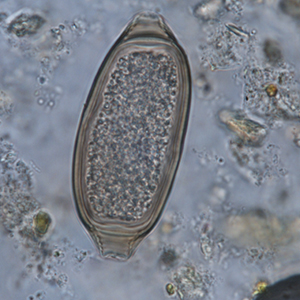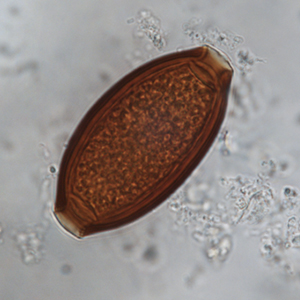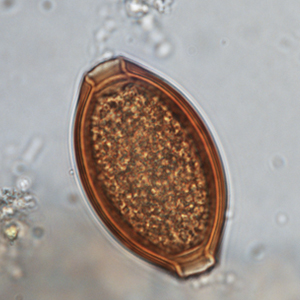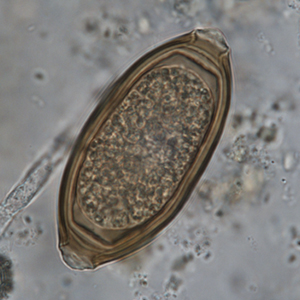Whipworms are nematodes of the Trichuridae family. The genus Trichuris is the most frequently described in non-human primates. Several dozens of species have been reported, the most frequent one in primates being Trichuris trichiura. This parasite affects the cecum and colon of primates (Strait et al., 2012).
Epidemiology
Whipworms have a worldwide distribution but are more prevalent in tropical and subtropical regions. They can affect many different non-human primate species, including New and Old-World Monkeys and Apes, namely macaques (Macaca spp.), baboons (Papio spp.), vervet monkeys (Chlorocebus spp.), howler monkeys (Alouatta spp.), squirrel monkeys (Saimiri spp.), wooly monkeys (Lagothrix spp.) and capuchin monkeys (Sapajus spp.) amongst other species (Calle & Joslin, 2015; Murphy, 2015; Rondón et al., 2021).
Description
Whipworm eggs are oval, symmetrical and have a barrel-like shape. They measure 50 to 80 µm long and 20 to 40 µm large. They have a regular and smooth outer membrane. Protruding polar plugs are present at either tips of the parasite, and they are linked to the egg by a striated insertion site. Ridges of this insertion site are perpendicular to the axis of the egg. It is impossible to distinguish species of whipworms by ovodiagnosis only (Garcia, 2021).
Differential diagnosis
The main differential diagnosis for whipworms are capillarids. They can be differentiated by the following criteria:
- Capillarid eggs have more of a sausage-like shape whereas whipworm eggs are barrel-shaped. This criterion may be difficult to identify on coproscopy.
- Polar plugs of capillarid eggs are flatter than those of whipworm eggs. However, polar plugs of whipworm eggs can become flat if the eggs have spent a long time in the environment and are slightly degraded.
- Capillarid and whipworm eggs have polar plugs which are linked to the egg by a striated insertion site. In capillarid eggs, ridges are parallel to the axis of the egg, whereas they are perpendicular to the axis of the egg in whipworms. This is the main element to consider when trying to differentiate the two types of eggs.
Iris (Iris spp.) pollen seeds are also included in the differential diagnosis for whipworms. These pollens have the same elongated form and are of the same size as whipworm eggs. However, their outer membrane is thinner, and their poles are less distinguishable. Moreover, their content is more heterogeneous (Petithory et al., 1995).
Clinical significance
In most cases, whipworm infections are asymptomatic in non-human primates. In case of massive infection, clinical signs like anorexia and mucoid diarrhea can appear and even lead to the death of the animal (Strait et al, 2012).
Prophylaxis and treatment
As Trichuris trichiura is also a human parasite, hygienic measures need to be taken in case of diagnosis.
Various treatments have been described in non-human primates (Strait et al., 2012; Calle & Joslin, 2015):
- Mebendazole: 15-20 mg/kg PO q12h or q24h during 3 to 5 days;
- Dichlorvos: 10 mg/kg PO q24h once or twice;
- Levamisole: 7.5 mg/kg SC or 10 mg/kg PO twice at two weeks interval;
- Albendazole: 10 mg/kg PO q24h during 3 days;
- Flubendazole: 27-50 mg/kg PO q12h during 5 days (only described in Papio ).












